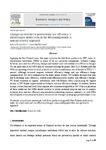Changes in total factor productivity and efficiency of microfinance institutions in the developing world: A non-parametric approach
| dc.contributor.author | Kar, AK | |
| dc.contributor.author | Rahman, Sanzidur | |
| dc.date.accessioned | 2018-10-30T15:49:04Z | |
| dc.date.available | 2018-10-30T15:49:04Z | |
| dc.date.issued | 2018-12 | |
| dc.identifier.issn | 0313-5926 | |
| dc.identifier.uri | http://hdl.handle.net/10026.1/12689 | |
| dc.description.abstract |
© 2018 Economic Society of Australia, Queensland Applying the Färe–Primont index, this paper computes the total factor productivity (TFP) index for microfinance institutions (MFIs) in terms of its six individual components: technical change, technical, scale and mix efficiency changes and residual scale and residual mix efficiency changes. We use panel data of 342 MFIs from 61 countries covering the period 2003–2013. Results show that MFIs are operating at a low level of productivity with an overall annual rate of decline in TFP of 1.7 percent. Although technical progress, technical efficiency change and mix efficiency change components of TFP have increased over the study period, overall, TFP actually declined over time due to declining scale efficiency, residual scale-efficiency and/or residual mix efficiency changes. We found variations in regional performance with Sub-Saharan Africa experiencing the highest decline in TFP despite improvements in technical and mix efficiency changes. In contrast, Eastern Europe, Central Asia and South Asian regions have experienced a growth in TFP. Policy implications of these results are that MFIs should continue to pursue technical progress and aim to improve technical, scale and mix efficiency components by reallocating resources optimally. As well, MFIs should operate at an optimal scale and derive economies of scope by changing input and output mixes. | |
| dc.format.extent | 103-118 | |
| dc.language | en | |
| dc.language.iso | en | |
| dc.publisher | The Economic Society of Australia Inc. | |
| dc.subject | Microfinance institutions | |
| dc.subject | Total factor productivity growth | |
| dc.subject | Fare-Primont productivity index | |
| dc.subject | Technical | |
| dc.subject | Scale and mix efficiency changes | |
| dc.subject | Cross-country panel data | |
| dc.subject | Non-parametric approach | |
| dc.title | Changes in total factor productivity and efficiency of microfinance institutions in the developing world: A non-parametric approach | |
| dc.type | journal-article | |
| dc.type | Journal Article | |
| plymouth.author-url | https://www.webofscience.com/api/gateway?GWVersion=2&SrcApp=PARTNER_APP&SrcAuth=LinksAMR&KeyUT=WOS:000450798100010&DestLinkType=FullRecord&DestApp=ALL_WOS&UsrCustomerID=11bb513d99f797142bcfeffcc58ea008 | |
| plymouth.volume | 60 | |
| plymouth.publication-status | Published | |
| plymouth.journal | Economic Analysis and Policy | |
| dc.identifier.doi | 10.1016/j.eap.2018.09.012 | |
| plymouth.organisational-group | /Plymouth | |
| plymouth.organisational-group | /Plymouth/Faculty of Arts, Humanities and Business | |
| plymouth.organisational-group | /Plymouth/Users by role | |
| dcterms.dateAccepted | 2018-09-27 | |
| dc.rights.embargodate | 2020-4-3 | |
| dc.rights.embargoperiod | Not known | |
| rioxxterms.versionofrecord | 10.1016/j.eap.2018.09.012 | |
| rioxxterms.licenseref.uri | http://www.rioxx.net/licenses/all-rights-reserved | |
| rioxxterms.licenseref.startdate | 2018-12 | |
| rioxxterms.type | Journal Article/Review |


